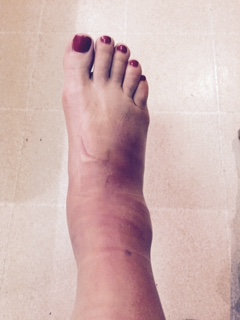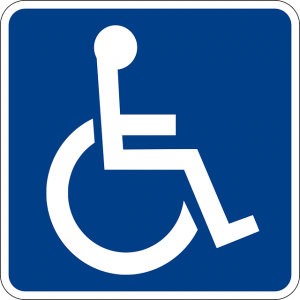I broke my ankle back in August while hiking on The Long Trail. The good news is that I was biking on the C&O Towpath by early September. The bad news is that the confidence with which I used to navigate the world on my feet has fled. Suddenly, I’m cautious not just about walking in the leaf-littered woods; I’m shaky about just getting dressed.
According to the CDC, one out three of older people falls each year. “Older” means 65 or more, and I’m not there yet. If I’m lucky, someday I will be. When I am, I don’t want to be one of those two and a half million elders who end up in the ER every year on account of a fall, and I certainly don’t want to become one of the 700,000 who are hospitalized yearly for fracturing a hip or breaking my head.
Most falls occur at home. At least I was on The Long Trail when I fell.

I walked another eight miles on my bum ankle, whether due to stupidity or stubbornness, I still can’t decide. I stopped to rest at Stratton Pond.
Remarkably, I walked another eight miles on my bum ankle, whether due to stupidity or stubbornness, I still can’t decide. Probably both.
I was exposed to only uneven ground, the most common risk factor for falls, and to be expected while hiking. I don’t have any of the physical ailments that raise the risk of falling down. These include lower body weakness, vitamin D deficiency, vision problems, foot pain, poor footwear or medicines that affect balance. I attribute my fall to inattentiveness: I was woolgathering, deeply preoccupied with my imagination. Given that it was my mental state that sent me tail over teacup, it’s only fitting that it’s a mental problem that persists. It’s a nagging fear that may save my life.
Like many healthy but bone-headed people, I have some habits I know are bad for my health. For years, I kept a swivel chair from an old office by the kitchen desk. And yes, I stood on it when I needed something from a high shelf, all the while ignoring the voice in my head saying, “I probably shouldn’t be standing on this.” It’s the same voice I ignore when I reach for a second cookie – or a third. Thanks to my fall, I’m starting to listen better, and I’ve already replaced the swivel chair with a stationary step stool.
But what’s good for my balance is bad for my ego, and I hate to admit that since breaking my ankle, I have trouble pulling on my socks standing up. Now I need a chair in the closet. Since this happened in the summer, the carpets were already mothballed for the season, but when I unrolled them last week, I anchored them with sticky under-padding to keep them in place. I also wondered if there would come a time when we wouldn’t be able to negotiate these rugs or even the few steps in and out of the house.
There’s a Native American saying not to judge a person until you’ve walked two moons in that person’s moccasins. It only takes six weeks in a cast to see how hard it is to negotiate the world at large with a disability despite twenty-five years of the Americans With Disabilities Act. Even when handicapped parking spaces are available, curbs and uneven pavement pose challenging conditions, right up to doors that are nearly impossible to open with crutches in hand. “Accessible” doesn’t always mean convenient. Learning this is making me a kinder person.
Kindness counts. If I didn’t already know this, six-weeks seated with my leg elevated would have done the trick. Perhaps one of the hardest things for a middle-aged person to learn is to accept help. Those friends and family who helped me stay seated, leg raised, did so without making me feel incompetent or useless; I was just temporarily out of service. I hope I can return the kindness not just to my friends, but also to strangers struggling through an accessible but inconvenient doors.
Meanwhile, I figure Middle Age is a good time to prepare for becoming “older” by practicing prevention. I’ve already learned that exercise is not optional, and I’ve added new strength-training and balance exercises to help prevent future falls. But the most remarkable new habit I’m trying to learn is single-tasking.
There was a time when I prided myself on my ability to help with homework, prepare dinner, and carry on a phone conversation with a client all at the same time. No longer.
Those days when multitasking was a matter of survival are over. Now, focusing on one task at a time is the order of the day. I don’t know if learning to single-task is a function of maturity or age, but it’s a practice that just might keep me upright as I hike down a trail.
I know: It could be galling to admit that I have to pay attention to things I used to be able to do as a matter of course. It’s also true that anyone could have a momentary mental lapse that sends them all akimbo, bruising ego and elbow alike. But like everyone else on the planet, I’m not getting younger, and I might as well start practicing these behaviors, so they’re ingrained by the time I leave Middle Age.
####
To receive new posts by email every Wednesday, enter your address in the box on the right, click “subscribe” and then check your email to confirm your subscription. Thanks.



Ah Deborah, how clever you are. I’m approaching 70 in the Spring and I have that being beyond the “middle ages”. Everything you wrote about caution and single tasking is also part of my life. It’s the latter that irritates me the most. Do you know that if you decide to look anywhere but straight ahead while driving, your car follows your eyes? Also, after feeding the dog, a phone call can (and does) result in leaving the open can of dog food plus the full bowl on the kitchen counter? Last summer I jumped off the deck (about 2 feet) and ended up flat out with my face planted in the grass. How is this even possible?
So keep preparing, you will be pleased you did when you turn 70. It is humbling.
Hi Annette, Thank you so much for both your affirmation and encouragement!
A face plant, eh? At least it wasn’t intentional – like walking eight miles on a broken ankle.
Maybe we need something akin to the Darwin Awards for the incomprehensible things we do as we age. All best, Deborah.
I’m in my 50s and forget that I’m getting older! I do try to be more careful so I don’t injure myself needlessly. I’ve been clumsy my entire life; falling during a hike is usually on my mind so I try hard to stay present. But, standing on a swivel chair? I’ve done that and other knucklehead moves. Good reminder to stay focused on a single task. BTW – my cousin had an accident 4 years ago, is paralyzed from the chest down, and is in a wheelchair. There are so many restaurants and stores that can’t accommodate him.
“Knucklehead moves” just about sums it up!
I’m sorry for your cousin. There does seem to be some energy for a new initiative around accessibility during this 25th anniversary year of the ADA.
Thanks for your comments, Deborah.
I know what you mean. Years ago I installed a grab bar in the guest bathroom shower for my mother when she visited. I’ve found it very useful over the year for me when I’ve done bone-head moves with my knees. Now I am thinking of installing more.
My wife broken her ankle a few years when a car hit the bike she was riding. Took her a good year to get her confidence back. It does come back, but she is more careful these days.
Grab bars and more care sound like to ingredients to safer aging! Glad to hear that your wife’s ankle did eventually heal. Thanks for your comment.